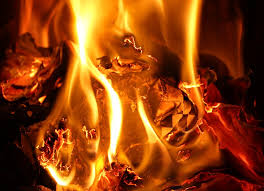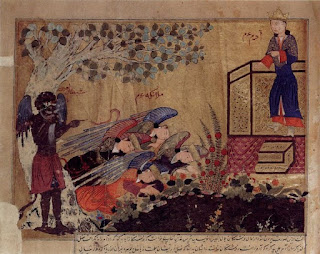In a kingdom in the snowy mountains there lives a strong, good-hearted group of people named the Gyrfallen who have always had very wise and young Kings. The Gyrfallen have occupied this mountain valley as long as anyone can remember. Unlike most kingdoms this one does not choose the successor of the King based on lineage or wealth but instead the new King is chosen by the god Gyr, unbeknownst to the people. Gyr is believed to take the shape of white falcon which encompasses all the qualities of those he favors: speed, cunning, wisdom, and beauty . The next King is determined by whom the white falcon seeks out and hunts for. This is a tale of truth behind the god Gyr and how their Kings acquire such vast amounts of wisdom at such young ages. We enter the story at the moment King John finishes drinking the poisoned spring water, after he kills his white falcon...
"Finally...something to drink", I thought to myself. That damn bird had lost its mind, constantly knocking the cup from my hands! Couldn't he see I was dying of thirst, and that the cup took an awful long time to fill? Well... I suppose if I ever make it back it will be time to find a new bird to take as a hunting companion. Now where am I, I wonder?
"Sire, is that you?!", yelled the captain, who was relieved to find his King after searching for two days.
"Sir, you don't look well! Please, don't tell me you drank from the spring. Villagers nearby told us that it was poisoned by the blood of hydra that was slain upstream from here!"
Immediately upon hearing this the King doubled over, vomiting and crying all at once. He realized now that the white falcon had simply been trying to protect him from the fate he was now destined to pursue.
"What a fool I am! How could I have thrown away my hunting companion so quickly? Had he not served me well for years, and hunted well and taught me the ways of the forest and kingdom? Though I am a King, in the end I now realize that I've become the lowest and most homely kind of man, the kind that doesn't trust the wisdom of his friend."
With that the disease overcame the body of the King, and his eyes rolled back. He awoke shortly in what he believed to be the next life, curious to see what lay ahead. It is here that he meets the spirit of the white falcon that he had thrown away in his rage.
"Wake up King John, it is time for you to fulfill your duty just as I have done and the King before me and the King before him. It is time for you to learn about the duty of the King in death and the history of our people and the world." said the white falcon.
"Gyr, is that you? I'm sorry old friend, for a brief moment I forsake all the wisdom and trust you had shared with me and, in a fit of rage, dashed you upon the rocks so I could drink the water. I know now that you only tried to protect me."
"Now, young King, is not the time for apologies..Nor am I Gyr. I am was once a King like you, in fact, I was known as King Eric and was the ruler prior to your reign. The god Gyr has blessed our people with the ability to be lead vicariously by previous Kings so that our knowledge may forever grow and that we may never make the same mistakes twice. So, when you die you must take the form of a white falcon and do as I did: search out the next King for our people, and teach him to be wise."
And so begins the quest of King John to find a suitable lad to become the next King and carry on the tradition of leading the Gyrfallen. As he took flight, he knew exactly where he would find the next ruler. He set course for the Lost Woods to find a young man who was named Link.
 |
| A Gyrfalcon. Found on pixabay. |
Author's Note
This story gains inspiration from all of the Tales of Bidpai that I had read but is especially influenced by the story of The King, the Falcon, and the Drinking-Cup. In the original story the king does not drink any of the water from the spring because his guard warns him in time. He realizes that his friend, the falcon, had only been trying to save him the entire time and became very distraught. And that is where the original story ends. Here I have added on to it a little bit and attempted to add more of a spiritual element to the original story.
Bibliography
Fables of Bidpai unit on canvas
The King, the Falcon, and the Drinking-Cup
The Tortoise and the Geese and Other Fables of Bidpai by Maude Dutton











